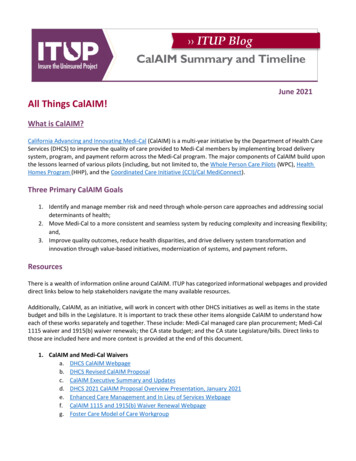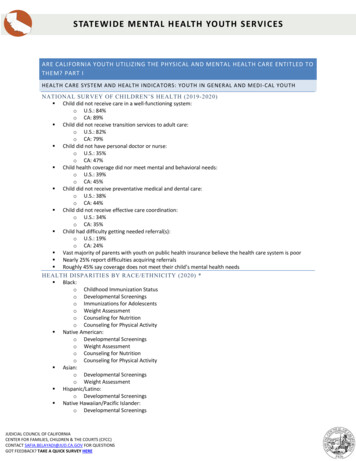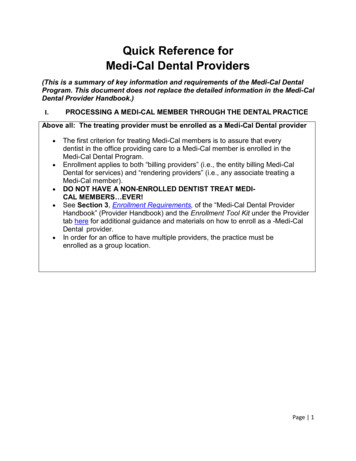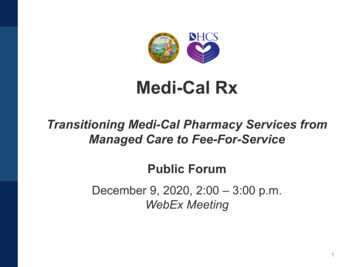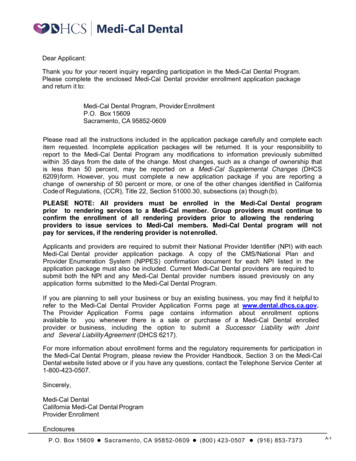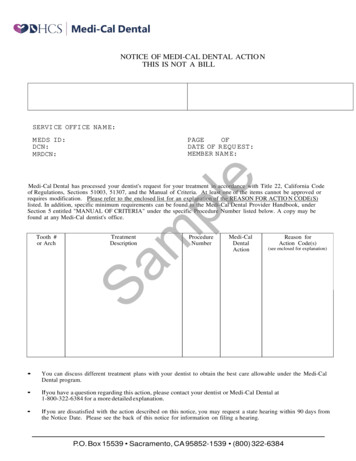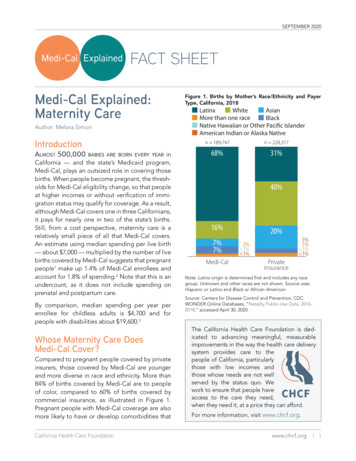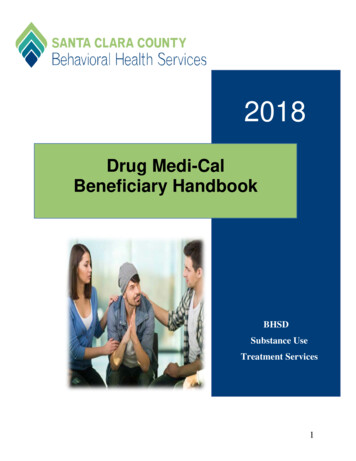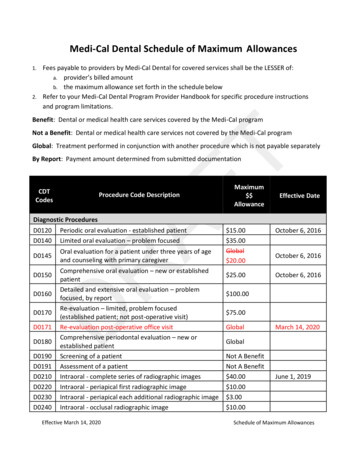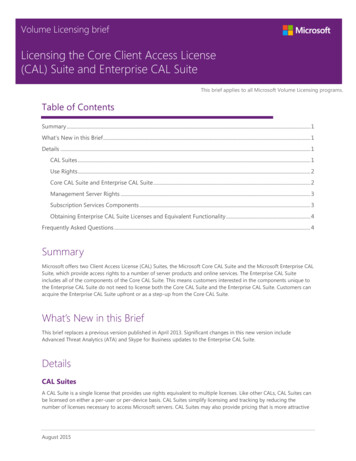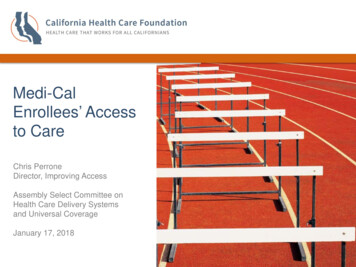
Transcription
Medi-CalEnrollees’ Accessto CareChris PerroneDirector, Improving AccessAssembly Select Committee onHealth Care Delivery Systemsand Universal CoverageJanuary 17, 2018
Overview Framework Findings Non-elderly Adults California research Focus on comparison of Medi-Cal to uninsured andindividual market coverage Key Program Features Summary Improvement Strategies2
Framework for Measuring Access Potential Access: Is care available? Is it affordable? Dopeople have a usual source of care? Realized Access: Are people getting care they need? Isit timely and appropriate? Outcomes: What is the impact on health? On financialwell-being?3
Populations differ in important waysSelected Population ed Full orPart TimeIncome 200%FPLFair or alDistressSource: California Health Interview Survey (CHIS), 2016. Non-elderly adults.4
Physician participation in Medi-Cal is insufficient, has notkept pace with enrollment growthSource: J. Coffman and M. Fix, Physician Participation in Medi-Cal: Is Supply Meeting Demand? (CHCF, 2017).5
Payment is the #1 reason physicians give for limiting theirparticipation in Medi-Cal. They also report greater difficultyobtaining referrals for their Medi-Cal patients.Source: J. Coffman and M. Fix, Physician Participation in Medi-Cal: Is Supply Meeting Demand? (CHCF, 2017).6
Access to care for adult Medi-Cal enrollees is generallycomparable to individual market and better than uninsuredHas Usual Source of Care90%85%Had Difficulty Finding Primary Care84%52%Employer IndividualDoctor's OfficeMedi-Cal UninsuredClinicOtherVisited Doctor Within Past uredHad Difficulty Finding Specialty Care80%56%EmployerIndividual1 visitMedi-Cal2 redUninsuredSource: California Health Interview Survey (CHIS), 2016. Those answering yes to either of the following questions were categorized as having difficulty finding care:During the past 12 months, did you have any trouble finding a general doctor (or medical specialist) who would see you? During the past 12 months, did a doctor’s(or medical specialist’s) office tell you that they would not take you as a new patient?7
Adult Medi-Cal enrollees are less likely to forgo care due tocost, but have more difficulty getting timely careDelayed Care Due to CostHad to Forgo Needed Medical lUninsured53%Able to Get Appointment Within 2 UninsuredNeverSource: California Health Interview Survey (CHIS), 20168
Secret shopper study shows challenges Medi-Cal enrolleesface getting timely care as a new patientPercent of Primary Care Physicians Listed in Plan Directory AsAccepting New Patients Who Had Available 14%10%6%El DoradoPlacerSacramento San JoaquinAvailable AppointmentSolanoSutterYoloYubaWithin 10 Business Days, Any Provider in Same PracticeSource: J. Melnikow, et al., Access to Primary Care Providers for Medi-Cal Patients: A Secret Shopper Study. UC Davis Center for HealthCare Policy and Research. Presentation on July 22, 2016. Ten business days based on 15 calendar days.9
Higher ED Use Among Adult Medi-Cal Enrollees ReflectsPopulation DifferencesVisited ED, Fair or Poor HealthVisited ED in Past d29%Visited ED, Fair or Poor Health andNo long-term dSource: California Health Interview Survey (CHIS). Pooled 2015 and 2016 data for non-elderly aduts.10
Some Medi-Cal enrollees experience more difficultyaccessing care than othersPreventable Hospitalizations,by Race/Ethnicity* (2011)Difficulty Finding Specialty Care,by Health Status (2016)36%1,91224%1,04616%727LatinoOther WhiteAfrican AmericanExcellentVG/Good/FairPoorDifficulty Finding Specialty Care,by Region (2015-16)Difficulty Finding Specialty Care,by Disability ilitySources: J. Watkins and J. Chen, Preventable Hospitalizations in Medi-Cal: Rates of Hospitalization for Ambulatory Care Sensitive Conditions in 2011 (DHCS,2015). Excludes children, seniors and persons with disabilities. California Health Interview Survey, 2016 and 2015-16 pooled. Non-elderly adults with Medi-Cal only.11
There is considerable variation in performance amongMedi-Cal managed care plansSource: Medi-Cal Managed Care Performance Dashboard, September 14, 2017 Release (DHCS, 2017). HEDIS is the Health Care Effectiveness Dataand Information Set, a tool used to measure quality of care and service in managed care.12
Quality of care in Medi-Cal managed care is similar tonational Medicaid average, but not improvingCervical Cancer Screening83%65%201364%201459%20152016 National2013Timely Prenatal High Blood Pressure ControlDiabetes Care - Testing201420152016 National58%56%20132014Child Immunization tional61%61%2015201657%NationalWell Child Visit – Ages 3-675%73%73%71%72%2013201420152016NationalSource: Managed Care Quality and Monitoring Division, Medi-Cal Managed Care External Quality Review Technical Report (DHCS, 2017).13
Public Plans Play A Unique Role in Medi-Cal Public plans outperform commercial plans on qualityin 9 of 12 counties where they compete head-to-head“Public plans were far more likely than commercialplans to make investments in safety-net clinics andwere more likely to pair payments with technicalassistance . Public plans provided far larger levelsof support targeted to expand access and implementpractice improvements within safety net clinics”1Several public plans making major investments toimprove access and quality. For example: Central California Alliance for Health’s ProviderRecruitment Program made 20 million availableto subsidize recruitment-related expenses forprimary care, specialty care, and behavioralhealth professionals2Enrollment by Plan Type(millions)Commercial3.4LA Care2.1OtherLocalInitiatives3.0COHS2.2Inland Empire Health Plan is investing in a 20million initiative to integrate behavioralhealthcare at the point of care with 13 entitiesacross 34 sites2Sources: (1) Pacific Health Consulting Group, Medi-Cal Managed Care Plans and Safety NetClinics Under the ACA (CHCF, 2015). (2) Manatt Health, Moving Medi-Cal Forward on the Path toDelivery System Transformation (CHCF, 2016).Source: DHCS, Managed Care EnrollmentReport, November 201714
Several features of Medi-Cal are intended to promotebetter access Expansive benefit, including dental and transportationservices No/low premiums and cost sharing Numerous legal and administrative protections forMedi-Cal enrollees Higher payments for selected providers/ services Retroactive and presumptive eligibility; enrollment openyear-round15
Most enrollees have positive perception of Medi-CalSource: Lake Research Partners, Medi-Cal at a Crossroads: What Medi-Cal Enrollees SayAbout the Program (CHCF, 2012).16
Summary Physician participation in Medi-Cal is insufficient By most measures, access to care for Medi-Cal enrolleesis significantly greater than for uninsured By many measures, access to care for Medi-Cal enrolleesand those with coverage through individual market iscomparable Privately insured more likely to delay care due to cost Medi-Cal enrollees more likely to have difficulty gettingtimely care Medi-Cal’s managed care infrastructure could beleveraged more effectively to improve access and quality17
Ideas for Improving Access Improve health plan performance through valuebased payment and contracting Encourage plans to expand access to telehealth Expand efforts to advance delivery systemtransformation Heed emerging recommendations from the CaliforniaFuture Health Workforce Commission Support efforts to measure and report networkadequacy, timely access, and health outcomes18
Adult Medi-Cal enrollees are less likely to forgo care due to cost, but have more difficulty getting timely care. 53% . 72% . 58% 75% . Employer. Individual. Medi-Cal. Uninsured. Had to Forgo Needed Medical Care 70% 66% . 48% . 63% . Employer. Individual. Medi-Cal. Uninsured. Able to Get Appointment Within 2 Days . Always/Usually. Sometimes .
